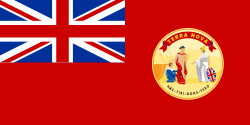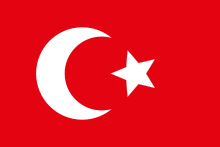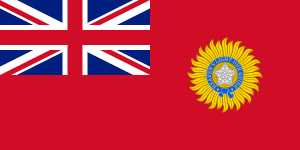
Moscow City Brotherly Cemetery in 1915
The First World War was fought on many fronts around the world from the battlefields of Europe to the far-flung colonies in the Pacific and Africa. While it is most famous for the trench combat stalemate that existed on Europe's Western Front, in other theatres of combat the fighting was mobile and often involved set-piece battles and cavalry charges. The Eastern Front often took thousands of casualties a day during the big offensive pushes but it was the West that saw the most concentrated slaughter. It was in the west that the newly industrialized world powers could focus their end products on the military-industrial complex. The deadliest day of the war was during the opening day of the conflict. The Imperial German war council had initiated the Schlieffen Plan which involved multiple armies flooding through the borders of Belgium and France. On August 22, 1914, during the Battle of the Frontiers five separate French armies engaged the German invaders independently of each other. Across all those battlefields, on that single day, 27,000 French soldiers lost their lives protecting their country.[1]
The term casualty in warfare can often be misleading. It often does not refer to those who are killed on the battlefield rather it refers to those who can no longer fight. This can include disabled by injuries, disabled by psychological trauma, captured, deserted, or missing. A casualty is by definition a soldier who is no longer available for the immediate battle or campaign, the major consideration in combat; the number of casualties is simply the number of members of a unit who are not available for duty. For example, on March 21, 1918, during the opening day of Kaiserschlacht, the Germans casualties are broken down into 10,851 killed, 28,778 wounded, 300 POW or taken prisoner for a total of 39,929 casualties.[2] The word casualty has been used in a military context since at least 1513.[3] In this article the numbers killed refer to those killed in action, killed by disease or someone who died from their wounds.
Western Front
| Country |
Battle, siege, or offensive |
Date |
Number killed on this day |
Total killed during WWI |
% of total killed |
References |
 France France |
Battle of the Frontiers |
August 22, 1914 |
27,000 |
1,357,000[4] |
2% |
[5] |
 United Kingdom United Kingdom |
Battle of the Somme |
July 1, 1916 |
19,240 |
744,000[6] |
3% |
[7] |
 German Empire German Empire |
Kaiserschlacht |
March 21, 1918 |
10,851 |
2,037,000[8][9] |
0.53% |
[2] |
.svg.png) Canada Canada |
Battle of Vimy Ridge |
April 9, 1917 |
2,414 |
56,639[10] |
4% |
[11] |
 Australia Australia |
Battle of Fromelles |
July 19, 1916 |
1,230 |
61,527[10] |
2% |
[12] |
 New Zealand New Zealand |
First Battle of Passchendaele |
October 12, 1917 |
847 |
18,166[13] |
5% |
[14] |
.svg.png) Belgium Belgium |
Massacre at Dinant |
August 23, 1914 |
674 |
38,170[15] |
2% |
[16] |
 First Portuguese Republic First Portuguese Republic |
Battle of the Lys |
April 9, 1918 |
500~[A 1] |
7,222[15] |
7% |
[17] |
.svg.png) United States United States |
Battle of the Argonne Forest |
October 4, 1918 |
418 |
116,516[18] |
0.36% |
[19] |
 Newfoundland Newfoundland |
Battle at Beaumont-Hamel (Somme) |
July 1, 1916 |
310 |
1,204[10] |
26% |
[20] |
.svg.png) South Africa South Africa |
Battle of Delville Wood |
July 18, 1916 |
253 |
7,121[10] |
4% |
[21] |
.svg.png) Russian Empire (until 1917) Russian Empire (until 1917) |
|
|
|
1,700,000 [15] |
|
|
 Polish Blue Army Polish Blue Army |
|
|
|
|
|
|
 Thailand SEF (from 1918) Thailand SEF (from 1918) |
Base Hospital No. 57 |
February 7, 1919 |
2 [A 2] |
19 [22] |
11% |
[22] |
Eastern Front
| Country |
Battle, Siege, or Offensive |
Date |
Number killed on this day |
Total killed during WWI |
% of total killed |
References |
.svg.png) Russian Empire Russian Empire |
|
|
|
1,700,000 [15] |
|
|
 German Empire German Empire |
|
|
|
2,037,000 [8] [9] |
|
|
 Romania Romania |
|
|
|
335,706 [23] |
|
|
 Bulgaria Bulgaria |
|
|
|
101,229 [A 3] [24] |
|
|
.svg.png) Austria-Hungary Austria-Hungary |
|
|
|
1,200,000 [25] |
|
|
 Ottoman Empire Ottoman Empire |
|
|
|
325,000 [A 4] [25] |
|
|
Naval battles
| Country |
Battle, siege, or offensive |
Date |
Number killed on this day |
Total killed during WWI |
% of total killed |
References |
 United Kingdom United Kingdom |
Battle of Jutland |
May 31, 1916 |
6,094 |
744,000[6] |
1% |
[26] |
 German Empire German Empire |
Battle of Jutland |
May 31, 1916 |
2,551 |
2,037,000[8][9] |
0.13% |
[26] |
_crowned.svg.png) Italy Italy |
SS Principe Umberto |
June 8, 1916 |
1,926 |
460,000[15] |
4% |
[27] |
 France France |
SS Gallia |
October 4, 1916 |
1,338 |
1,357,000[4] |
0.1% |
[28] |
.svg.png) Austria-Hungary Austria-Hungary |
SS Linz |
February 20, 1918 |
697[A 5] |
1,200,000[25] |
0.06% |
[29] |
.svg.png) Russian Empire Russian Empire |
Cruiser Pallada |
October 11, 1914 |
597 |
1,700,000[15] |
0.04% |
[30] |
.svg.png) Empire of Japan Empire of Japan |
Battleship Kawachi |
July 12, 1918 |
500–700[A 6] |
4,661[31] |
13% |
[32] |
.svg.png) United States United States |
USS Cyclops |
After March 4, 1918 [A 7] |
309 |
116,516[18] |
0.3% |
[33] |
 Ottoman Empire Ottoman Empire |
Barbaros Hayreddin[A 8] |
August 8, 1915 |
258 |
325,000[A 9][25] |
0.07% |
|
.svg.png) Canada Canada |
HMHS Llandovery Castle |
June 27, 1918 |
234 |
56,639[10] |
0.4% |
[35] |
Gallipoli Campaign
| Country |
Battle, siege, or offensive |
Date |
Number killed on this day |
Total killed during WWI |
% of total killed |
References |
 Ottoman Empire Ottoman Empire |
Third attack on Anzac Cove |
May 19, 1915 |
5000~ |
325,000[A 10][25] |
2% |
[36] |
 France France |
First Battle of Krithia |
April 28, 1915 |
[A 11] |
1,357,000[4] |
|
[37] |
 United Kingdom United Kingdom |
Battle of Scimitar Hill |
August 21, 1915 |
1497–[A 12] |
744,000[6] |
0.2% |
[39] |
 Australia Australia |
ANZAC Cove |
April 25, 1915, August 7, 1915[A 13] |
755 |
61,527[10] |
1.2% |
[40][41] |
 New Zealand New Zealand |
Battle of Sari Bair |
August 8, 1915 |
507 |
18,166[13] |
3% |
[42][43] |
 India India |
Third Battle of Krithia |
June 4, 1915 |
207[A 14] |
42,448[A 15][A 16][46] |
0.5% |
[47] |
Italian Front
| Country |
Battle, Siege, or Offensive |
Date |
Number killed on this day |
Total killed during WWI |
% of total killed |
References |
_crowned.svg.png) Italy Italy |
|
|
|
460,000 [15] |
|
|
 France France |
|
|
|
1,357,000 [4] |
|
|
 United Kingdom United Kingdom |
|
|
|
744,000 [6] |
|
|
 German Empire German Empire |
|
|
|
2,037,000 [8] [9] |
|
|
.svg.png) Austria-Hungary Austria-Hungary |
|
|
|
1,200,000 [25] |
|
|
Macedonian Front
| Country |
Battle, Siege, or Offensive |
Date |
Number killed on this day |
Total killed during WWI |
% of total killed |
References |
.svg.png) Greece Greece |
|
|
|
6,000~ [15] |
|
|
.svg.png) Serbia Serbia |
|
|
|
127,535 [A 17] [15] |
|
|
_crowned.svg.png) Italy Italy |
|
|
|
460,000 [15] |
|
|
 France France |
|
|
|
1,357,000 [4] |
|
|
 United Kingdom United Kingdom |
|
|
|
744,000 [6] |
|
|
.svg.png) Russian Empire Russian Empire |
|
|
|
1,700,000 [15] |
|
|
 German Empire German Empire |
|
|
|
2,037,000 [8] [9] |
|
|
 Bulgaria Bulgaria |
|
|
|
101,229 [A 18] [24] |
|
|
.svg.png) Austria-Hungary Austria-Hungary |
|
|
|
1,200,000 [25] |
|
|
 Ottoman Empire Ottoman Empire |
|
|
|
325,000 [A 19] [25] |
|
|
Annotations
- ↑ Portuguese faced the Germans for three days, from April 9-11, 1918. Around 500–700 were killed in action, mostly on the first day
- ↑ Two died after the war had ended. Three others died during the war on three different days:
February 11, 1918
March 1, 1918
October 21, 1918 - ↑ Killed 48,917 + Died of wounds 13,198 + Accidental deaths 888 + Died of disease 24,497 + Missing presumed dead 13,729
- ↑ Killed 50,000 + Died of wounds 35,000 + Died of disease 240,000
- ↑ Hundreds of unregistered passengers, mostly Austro-Hungarian soldiers returning from leave who boarded Linz illegally at Zelenika. Some estimations go as high as 2,700 people killed
- ↑ Sources differ widely on the exact number of men killed. Gardiner and Gray and Jentschura, Jung and Mickel agree on 700, but Lengerer says 600 and Kingsepp gives 618 killed from a crew of 960
- ↑ Cyclops was last seen outside of Baltimore on March 4, 1918
- ↑ On 3 May 1915 the steamer Gul Djemal with 4000 troops on board was torpedoed and sunk by HM Submarine E-14. The number of casualties are unknown; the British claimed many were lost, while German and Turkish records report limited casualties only.
- ↑ Killed 50,000 + Died of wounds 35,000 + Died of disease 240,000
- ↑ Killed 50,000 + Died of wounds 35,000 + Died of disease 240,000
- ↑ 14,000 Allied troops participated in the battle and suffered 2,000 British and 1,001 French casualties [37]
- ↑ 5,300 casualties out of the 14,300 soldiers who participated [38]
- ↑ Both days saw 755 Australians die
- ↑ 220 Indians died on all fronts[44]
- ↑ In Gallipoli 1,358 Indians died, 3421 were wounded for a total of 4,779 casualties[45]
- ↑ Excludes followers[46]
- ↑ Killed 45,000 + Missing presumed dead 82,535
- ↑ Killed 48,917 + Died of wounds 13,198 + Accidental deaths 888 + Died of disease 24,497 + Missing presumed dead 13,729
- ↑ Killed 50,000 + Died of wounds 35,000 + Died of disease 240,000
Bibliography
Notes
- ↑ Lucas 2017
- 1 2 Middlebrook 2007, p. 312
- ↑ Oxford English Dictionary, 2nd ed gives a 1513 reference for military casualty, and an 1844 reference for civilian use
- 1 2 3 4 5 War Office 1922, pp. 352–357
- ↑ Trouillard 2014
- 1 2 3 4 5 Anglesey 1995, p. 307
- ↑ BBC News 2017
- 1 2 3 4 5 Reichswehr 1934, pp. 12–14
- 1 2 3 4 5 Ellis & Cox 2001, p. 269
- 1 2 3 4 5 6 War Office 1922, p. 237
- ↑ Veterans Affairs Canada 2017
- ↑ Commonwealth War Graves Commission AUS 2017
- 1 2 Auckland War Memorial Museum 2017
- ↑ Commonwealth War Graves Commission NZ 2017
- 1 2 3 4 5 6 7 8 9 10 11 War Office 1922, p. 352
- ↑ history.com 2017
- ↑ Pyles 2012, p. 120
- 1 2 DeBruyne 2017, p. 2
- ↑ Brown 2013, p. 191
- ↑ Veterans Affairs Canada 2015
- ↑ Commonwealth War Graves Commission SA 2017
- 1 2 Whyte 2008
- ↑ War Office 1922, p. 353
- 1 2 War Office 1922, p. 354
- 1 2 3 4 5 6 7 8 War Office 1922, p. 357
- 1 2 Dickmann 2017, p. 25
- ↑ Helgason 2017a
- ↑ Helgason 2017b
- ↑ Wrecksite.eu 2017
- ↑ Sondhaus 2014, p. 190
- ↑ International Labour Office 1923, p. 29
- ↑ Nash 1976, p. 304
- ↑ Grohman 2008, p. 135
- ↑ Porter & Wynn 2015, p. 98
- ↑ Moorehead 1998, p. 151
- 1 2 Aspinall-Oglander 1992, p. 294
- ↑ Aspinall-Oglander 1992, pp. 354–355
- ↑ Commonwealth War Graves Commission UK 8-21 2017
- ↑ Commonwealth War Graves Commission AUS 4-25 2017
- ↑ Commonwealth War Graves Commission AUS 8-7 2017
- ↑ Ministry for Culture and Heritage 2014
- ↑ Commonwealth War Graves Commission NZ-ME 2017
- ↑ Commonwealth War Graves Commission IND 6-04 - Total 2017
- ↑ Ministry for Culture and Heritage 2016
- 1 2 War Office 1922, p. 348
- ↑ Commonwealth War Graves Commission IND 6-04 2017
References
- Anglesey, Lord (1995). A History of the British Cavalry: Volume 8: 1816-1919 The Western Front, 1915-1918, Epilogue, 1919-1939. Pen and Sword. ISBN 9781473815056.
- Total pages: 224
- Aspinall-Oglander, C. F. (1992). Military Operations: Gallipoli. Imperial War Museum. ISBN 9780898391756.
- Total pages: 602
- Auckland War Memorial Museum (2017). "World War One Hall of Memories". Auckland War Memorial Museum. Retrieved November 10, 2017.
- BBC News (2017). "WW1: Why was the first day of the Somme such a disaster?". BBC News. Retrieved November 10, 2017.
- Brown, Meredith Mason (2013). Touching America's History: From the Pequot War Through World War II. Indiana University Press. ISBN 9780253008336.
- Total pages: 271
- Commonwealth War Graves Commission AUS 4-25 (2017). "Australia April 25, 1915". Commonwealth War Graves Commission. Retrieved November 10, 2017.
- Commonwealth War Graves Commission AUS 8-7 (2017). "Australia August 7, 1915". Commonwealth War Graves Commission. Retrieved November 10, 2017.
- Commonwealth War Graves Commission AUS (2017). "Australia July 19, 1916". Commonwealth War Graves Commission. Retrieved November 10, 2017.
- Commonwealth War Graves Commission IND 6-04 - Total (2017). "ALL Indians June 4, 1915". Commonwealth War Graves Commission. Retrieved November 10, 2017.
- Commonwealth War Graves Commission IND 6-04 (2017). "India June 4, 1915". Commonwealth War Graves Commission. Retrieved November 10, 2017.
- Commonwealth War Graves Commission NZ (2017). "New Zealand October 12, 1917". Commonwealth War Graves Commission. Retrieved November 10, 2017.
- Commonwealth War Graves Commission SA (2017). "South Africa July 18, 1916". Commonwealth War Graves Commission. Retrieved November 10, 2017.
- Commonwealth War Graves Commission NZ-ME (2017). "New Zealand in Gallipoli". Commonwealth War Graves Commission. Retrieved November 13, 2017.
- Commonwealth War Graves Commission UK 8-21 (2017). "United Kingdom in Gallipoli". Commonwealth War Graves Commission. Retrieved November 13, 2017.
- DeBruyne, Nese F. (2017). American War and Military Operations Casualties: Lists and Statistics (PDF). Congressional Research Service.
- Total pages: 38
- Dickmann, Nancy (2017). The Horror of World War I. Raintree. ISBN 9781474749381.
- Total pages: 48
- Ellis, John; Cox, Michael (2001). The World War I Databook: The Essential Facts and Figures for All the Combatants. Aurum Press. ISBN 9781854107664.
- Total pages: 323
- Grohman, Adam M. (2008). Claimed by the Sea - Long Island Shipwrecks. LULU.com. ISBN 9780578008073.
- Total pages: 241
- Helgason, Guðmundur (2017a). "Ships hit during WWI: Principe Umberto". uboat.net. Retrieved November 13, 2017.
- Helgason, Guðmundur (2017b). "Ships hit during WWI: Armed merchant cruiser Gallia". uboat.net. Retrieved November 13, 2017.
- Helgason, Guðmundur (2017c). "Ships hit during WWI: Sailing ship Cantatrice". uboat.net. Retrieved November 13, 2017.
- History.com (2017). "Germans burn Belgian town of Louvain". History (U.S. TV network). Retrieved November 10, 2017.
- International Labour Office (1923). "Tom 4, II Les tués et les disparus". Enquête sur la production. Rapport général. Paris Berger-Levrault. OCLC 6445561.
- Langensiepen, Bernd; Güleryüz, Ahmet (1995). The Ottoman Steam Navy 1828–1923. London: Conway Maritime Press. ISBN 978-0-85177-610-1.
- Lucas, Jon (November 5, 2017). "10 Deadliest Days on WWI's Western Front". Retrieved November 14, 2017.
- Moorehead, Alan (1998). Gallipoli. Wordsworth Editions. ISBN 9781853266751.
- Total pages: 319
- Middlebrook, Martin (2007). The Kaiser's Battle. Pen and Sword. ISBN 9781844154982.
- Total pages: 430
- Ministry for Culture and Heritage (December 5, 2014). "NZ Gallipoli casualties by month". Ministry for Culture and Heritage. Retrieved November 13, 2017.
- Ministry for Culture and Heritage (March 1, 2016). "Gallipoli casualties by country". Government of New Zealand. Retrieved November 15, 2017.
- Nash, Jay Robert (1976). Darkest Hours. Rowman & Littlefield. ISBN 9781590775264.
- Total pages: 826
- Porter, Ken; Wynn, Stephen (2015). Castle Point in the Great War. Pen and Sword. ISBN 9781473855175.
- Total pages: 176
- Pyles, Jesse (2012). "The Portuguese Expeditionary Corps in World War I: From Inception to Combat Destruction, 1914-1918" (PDF). University of North Texas. Retrieved November 10, 2017.
- Reichswehr (1934). "Heeres-Sanitaetsinspektion im Reichskriegsministeriums". Sanitaetsbericht über das deutsche Heer, (deutsches Feld- und Besatzungsheer), im Weltkriege 1914–1918 (in German). vol. 3 (Sec. 1).
- Sondhaus, Lawrence (2014). The Great War at Sea: A Naval History of the First World War. Cambridge University Press. ISBN 9781107036901.
- Total pages: 407
- Trouillard, Stéphanie (August 22, 2014). "August 22, 1914: The bloodiest day in French military history". France 24. Retrieved November 10, 2017.
- Veterans Affairs Canada (2017). "Canada - April 9, 1917". Veterans Affairs Canada. Retrieved November 10, 2017.
- Veterans Affairs Canada (November 5, 2015). "The Opening Day, Battle of the Somme, 1916". Veterans Affairs Canada. Retrieved November 10, 2017.
- War Office, United Kingdom (1922). Statistics of the Military Effort of the British Empire During the Great War. 1914-1920. Her Majesty's Stationery Office (HMSO) .
- Total pages: 880
- Wrecksite.eu (2017). "SS Linz [+1918]". wrecksite.eu. Retrieved November 13, 2017.
- Whyte, Brendan and Suthida (2008). "The Inscriptions on the First World War Volunteers Memorial, Bangkok" (PDF). Journal of the Siam Society, Vol. 96. Retrieved December 27, 2017.
.jpg)

